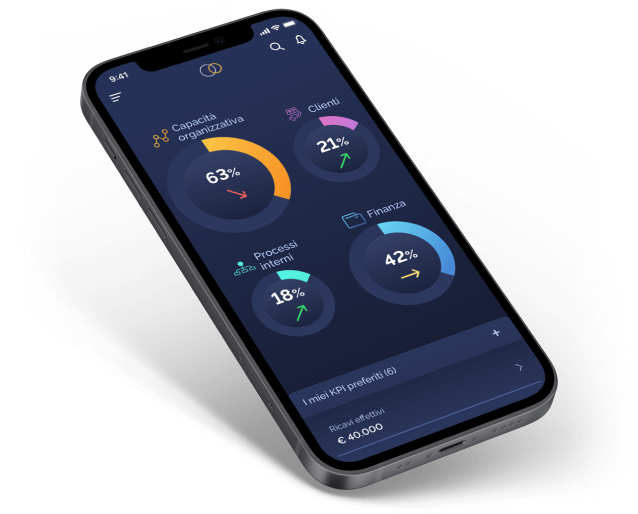
It is now a commonplace to say that without information management systems, it is impossible to make any organization work. Information is like health: you realize how precious it is when it is lacking, even in part. Companies, organizations operating in the market, have only one alternative: to have information systems that contribute to making them more competitive, today, tomorrow, and the day after tomorrow, or systems that simply administer current management. It is the difference between having an ERP (Enterprise Resource Planning) and a “management system”.
Some SMEs have a “management system.” Others have an ERP but use it like a management system. Still, others have an ERP and exploit its potential, more or less fully.
It’s not an “academic” distinction: it’s the difference between collecting information in the company and managing the company with information.
Collecting information in the company means recording what happens, day after day, in a punctual, precise, systematic way.
Managing the company with information means making things happen in a certain way using information, and then recording what happens, day after day, in a punctual, precise, systematic way, to verify if what was planned has been done in the quantity, on time, with the quality, and in the ways decided earlier.
Concretely, it means that a company that uses an ERP well will be able to know, with the necessary advance to prepare everything needed, whether a certain production and delivery program necessary to satisfy the customer will be feasible or will encounter certain difficulties due to a lack of materials, people, machines. Something that a company using a “management system” or using an ERP as a management system will find it challenging to do.
The choice to adopt an ERP is a change in business management. Therefore, it is a strategic decision that can determine the future of a company.
So, what is an ERP system, and why is it so important? We will do this with a brief history, and above all, we will discover Thauma, a new solution for Italian SME CEOs.
How is an ERP defined?
ERP stands for “Enterprise Resource Planning.” It refers to the software used to support business processes. But it also de facto indicates the most widespread standard for defining business processes, that is, their classification and description.
Unfortunately, business processes, these unknowns, are invisible.
Grabbing a ball in mid-air, an action that a young child can do, is a process that requires an enormous amount of information managed in fractions of a second: an intention, a perception, a calculation, a command to the muscles, an ongoing verification… It would take tens or hundreds of pages to describe that process in detail. In reality, only the activity and its result are visible: either the ball is caught or missed.
When looking at the organization of a business, one sees operations and materials, people and machines, warehouses and offices, but the business processes remain beneath the surface. In fact, what makes organizations work are precisely the business processes, which start from resources and produce results through activities. The ERP supports the nervous system of business processes, the information that governs them.
As examples of typical business processes in manufacturing companies, there are the procurement of goods and services, their production and shipment, even before their sale and design.
It is easier to understand what was said initially. The ERP has a technological framework capable of supporting business processes, and that technological framework has long been based on ICT (Information and Communication Technology). The ERP also has a functional core capable of defining business processes, and that functional core has been based on BPM (Business Process Management) for a shorter time.
The task of the ERP is to synchronize all business processes, allowing the realization of planned activities by balancing effectiveness (doing the right thing) and efficiency (doing things well) in the given situation of a certain company.
For Italian SMEs that have the “basics” in place (products and resources), the problem of managing business processes and related IT technology is rapidly becoming the difference between success and failure.
Why is an ERP so important?
If it is true that without information, no business organization can be managed, and that the quality of information makes a difference, the choice to adopt an ERP is almost mandatory.
The fundamental concept of ERP is that there is a “better way” to carry out a certain business process (“best practice”), and this model is implemented in BPM.
The ERP structures the flows of information that govern the execution of activities in such a way as to integrate them into a chain where each activity can be a customer of the upstream activity and a supplier of the downstream activity.
- The integration of various tasks within business processes, and between business processes, has two purposes:
- Ensure efficiency by eliminating redundancies (cost reduction)
- Ensure effectiveness (meeting deadlines and results) through coordination.
Every ERP software provides various “best practices” within the same standard, and their selection occurs in the extremely delicate initial phase of system setup: making a mistake in this phase jeopardizes not only the ERP project but also the operation of the entire company.
In fact, an ERP that does not work literally paralyzes the company: it becomes impossible to buy, produce, deliver, invoice, collect payments…
Short history of ERPs
Everything begins with the search for “scientific management of production” in the early 1900s. In 1913, engineer Ford Whitman Harris developed the EOQ (Economic Order Quantity) model, known as the “Economic Lot,” which serves inventory management by defining the optimal purchase quantity to minimize the sum of procurement costs and inventory holding costs. Unfortunately, at that time, the only tool available was paper.
The model, albeit rudimentary, became a standard for supply management for decades until the tool manufacturer Black & Decker started using a Material Requirements Planning (MRP) system in 1964. By adopting “look forward” logic instead of “look backward,” the MRP system moved the EOQ concepts from paper to computers.
The MRP system managed a single activity: procurement. About twenty years later, in 1983, MRP II was developed. The innovation of that “II” lay in the addition of modules for comprehensive resource planning: not only material availability but also the capacity of people and machines.
For the first time, various planning activities, from procurement to production, from shipping to delivery, were integrated into a single system.
MRP II was the first step towards integrating all business processes within a single software system to support such a system. In fact, the subsequent evolution involved integrating the remaining operational processes, as well as accounting, business, and organizational processes.
The system obtained, no longer referred to as MRP II, was defined as ERP in 1990.
From their inception until today, ERPs continue to evolve, and investments in this area have never stopped growing. In the coming years, further growth is expected, despite an economic context that is anything but “optimistic”.
However, the reasons for the continued growth of ERPs differ between large enterprises and SMEs.
In large enterprises, ERP is a powerful tool for integrating diverse realities. The wave of acquisitions and mergers that began in 1990 was facilitated by the fact that the buyer could integrate the purchase within a few months by imposing its own ERP.
In SMEs, ERP has offered the opportunity to make a qualitative leap compared to semi-artisanal business processes implemented with limited information systems, often limited to accounting. It allowed for advanced implementations with relatively modest investments within reach of almost all businesses.
Another boost to the spread of ERPs comes from the widespread adoption of the cloud, enabling the adoption of ERP in Software as a Service (SaaS) mode. This mode solves complex infrastructure problems (security, interoperability on different devices, etc.) that SMEs, with limited in-house technical and IT structures, couldn’t afford to successfully address.
It must be evident that all this comes at a cost: ERP is complex. It does many things but is a tool for specialists with high knowledge of business processes and their support through computer applications. It is not easy to use and provides information only to those who know all the keys to finding it. Moreover, typically, it is not for top management.
Thauma, the cloud, and artificial intelligence at the service of CEOs
The pervasive and compelling digital transition compels even the most “conservative” companies to transform, risking serious business continuity issues for those who insist on the “it’s always been done this way” approach. It is now clear that following the trends imposed by digital transformation in companies is a priority.
As the need for information to lead and manage becomes increasingly sensitive and urgent, data-driven companies continue to emerge, bringing the data culture not only into technical or economic contexts but into every area of the company.
Having data, from both internal and external sources, is no longer a problem. Rather, the challenge lies in transforming data into meaningful information for those making decisions in the company. On this front, information technology has made tremendous strides, leveraging Artificial Intelligence (AI) to develop future projections through sophisticated algorithms.
Thus, analyzing one’s sector and comparing with competitors, ensuring customer satisfaction, evaluating production processes, analyzing resources and results (everything falling within the Management Control System) are some of the first crucial examples of information for those leading a company toward a successful future.
In the Italian context, not particularly known for innovation and dynamism, CEOs of SMEs must be empowered to introduce changes in their governance approach.
In his role, the CEO must be able to set objectives based on objective indications as well as his intuition and vision, and, on the other hand, develop an action plan to meet these objectives with timely indications of what is working and what is not in the company.
The analysis of strategic lines and business processes must be clear, direct, and above all, easy to understand and quickly accessible. These indications are generally not found in traditional ERP systems. Therefore, a paradigm shift becomes necessary.
Thauma is “the” business application that more than others interprets this paradigm. It is indeed the first application on the market capable of concretely supporting the CEO’s activity, allowing them to have their company at their fingertips directly on their smartphone. (To learn more about Thauma, read here the interview with Massimiliano Oleotto, Managing Director and creator of this digital “wonder”).
Thauma surpasses all those access and usability limits of ERP that make it challenging for the CEO and consolidates all the summaries of competitive comparisons, strategic lines, and business processes—results, objectives, and activities—within a single application.
The ERP remains necessary “below”, but “above”, at the CEO level, it cannot be sufficient.
Because there is a need for a tool capable of performing the synthesis work required to make all business decisions. In other words, there is a need for a tool to support the company’s governance, and Thauma is that tool.







